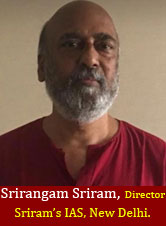“In spite of the humongous work that has been done in the field of public health care, Covid-19 exposed basic structural deficiencies in it.” Critically discuss.
Sakshi Education
By Srirangam Sriram, Sriram's IAS, New Delhi.

India has been polio-free since 2014. In a country of 1.2 billion people, this is a big deal. We have also been free of tetanus since 2015 and have set strict targets for the elimination of malaria, tuberculosis (TB), and lymphatic filariasis in the coming years. While we still represent a large percentage of the global burden for these diseases, we’ve made significant progress. Immunisation for 12 vaccine- preventable diseases is in the public domain, free of cost for every citizen.
The Swachh Bharat Abhiyan, or Clean India Movement, has provided a big push in the right direction to reduce the spread of communicable diseases.
But As communicable diseases trend downward, we’ve seen new challenges emerge around non-communicable diseases like hypertension, diabetes, cardiovascular diseases, stroke, and cancer. These diseases impact the rich in India as much as they impact the poor, but most poor people don’t have the resources to combat diseases like cancer. Our public health system isn’t geared toward noncommunicable diseases. So for India as a country, the challenge going forward is to focus on prevention, support, and awareness.
The National Health Mission (NHM)—the result of a 2013 merger between the National Urban Health Mission and the National Rural Health Mission—is a prominent example. The program’s primary focus is on disease control, prevention, and surveillance, and it has already made a huge impact on our health care system.
IMR and MMR have improved markedly. India has saved a huge number of infants through multiple interventions—including an increase in institutional birthing, immunization coverage, and improved sanitation.
In the past decade, India has implemented a digital health program called eVIN to track immunization. The program is critically important for the country because of the size of our population. ANMOL is another important digital health tool, providing better health care services to pregnant women, mothers, and newborns. India continues to struggle with high maternal and neonatal mortality rates, so tracking and providing services to new moms is important—especially for the country’s poorest and most vulnerable people.
But covid-19 exposed certain structural flaws in our health policy: As a country, India allocates only 1.15 percent of our gross domestic product (GDP) to health care—one of the world’s lowest rates considering the size of our population. Much of the funding that is allocated to health care is not being used, and a major lack of staff further leads to the underutilization of budgets. Indian health care organizations often have trouble recruiting, as we don’t have enough trained professionals who want to work in rural villages or health centers. Without reliable health services, people living outside of major cities suffer from a growing economic disadvantage.
 Covid-19 taught us the importance of investing in basic healthcare, surveillance systems. Also, the gaps in public health, on primary care, on communicable disease control programmes were exposed. We were not able to afford enough test kits to make it available for anyone on demand. We do not have adequate laboratories. to test those kits. It is largely because we did not invest enough in public health infrastructure. Infectious diseases and pandemics, which hurt so much, require community participation. We need to spend on bringing in behaviour change. They are done at the community level and that require investment.
Covid-19 taught us the importance of investing in basic healthcare, surveillance systems. Also, the gaps in public health, on primary care, on communicable disease control programmes were exposed. We were not able to afford enough test kits to make it available for anyone on demand. We do not have adequate laboratories. to test those kits. It is largely because we did not invest enough in public health infrastructure. Infectious diseases and pandemics, which hurt so much, require community participation. We need to spend on bringing in behaviour change. They are done at the community level and that require investment.
The Swachh Bharat Abhiyan, or Clean India Movement, has provided a big push in the right direction to reduce the spread of communicable diseases.
But As communicable diseases trend downward, we’ve seen new challenges emerge around non-communicable diseases like hypertension, diabetes, cardiovascular diseases, stroke, and cancer. These diseases impact the rich in India as much as they impact the poor, but most poor people don’t have the resources to combat diseases like cancer. Our public health system isn’t geared toward noncommunicable diseases. So for India as a country, the challenge going forward is to focus on prevention, support, and awareness.
The National Health Mission (NHM)—the result of a 2013 merger between the National Urban Health Mission and the National Rural Health Mission—is a prominent example. The program’s primary focus is on disease control, prevention, and surveillance, and it has already made a huge impact on our health care system.
IMR and MMR have improved markedly. India has saved a huge number of infants through multiple interventions—including an increase in institutional birthing, immunization coverage, and improved sanitation.
In the past decade, India has implemented a digital health program called eVIN to track immunization. The program is critically important for the country because of the size of our population. ANMOL is another important digital health tool, providing better health care services to pregnant women, mothers, and newborns. India continues to struggle with high maternal and neonatal mortality rates, so tracking and providing services to new moms is important—especially for the country’s poorest and most vulnerable people.
But covid-19 exposed certain structural flaws in our health policy: As a country, India allocates only 1.15 percent of our gross domestic product (GDP) to health care—one of the world’s lowest rates considering the size of our population. Much of the funding that is allocated to health care is not being used, and a major lack of staff further leads to the underutilization of budgets. Indian health care organizations often have trouble recruiting, as we don’t have enough trained professionals who want to work in rural villages or health centers. Without reliable health services, people living outside of major cities suffer from a growing economic disadvantage.
 Covid-19 taught us the importance of investing in basic healthcare, surveillance systems. Also, the gaps in public health, on primary care, on communicable disease control programmes were exposed. We were not able to afford enough test kits to make it available for anyone on demand. We do not have adequate laboratories. to test those kits. It is largely because we did not invest enough in public health infrastructure. Infectious diseases and pandemics, which hurt so much, require community participation. We need to spend on bringing in behaviour change. They are done at the community level and that require investment.
Covid-19 taught us the importance of investing in basic healthcare, surveillance systems. Also, the gaps in public health, on primary care, on communicable disease control programmes were exposed. We were not able to afford enough test kits to make it available for anyone on demand. We do not have adequate laboratories. to test those kits. It is largely because we did not invest enough in public health infrastructure. Infectious diseases and pandemics, which hurt so much, require community participation. We need to spend on bringing in behaviour change. They are done at the community level and that require investment.Published date : 30 Nov 2020 01:34PM






